Packing light means more freedom when you travel. With less to lug around, you can easily maneuver through crowded spots, speed through baggage claim, make last-minute plans without worrying what to do with your stuff and spend less time tracking gear. Going light makes even more sense now that many airlines charge fees for bags or luggage that exceeds certain size or weight restrictions.
Packing light for adventure travel can seem difficult at first, but like any new skill, you learn and get better the more you do it. This article gives you tips on how to pack light and smart.
Consider the 1-2-3-4-5-6 Rule
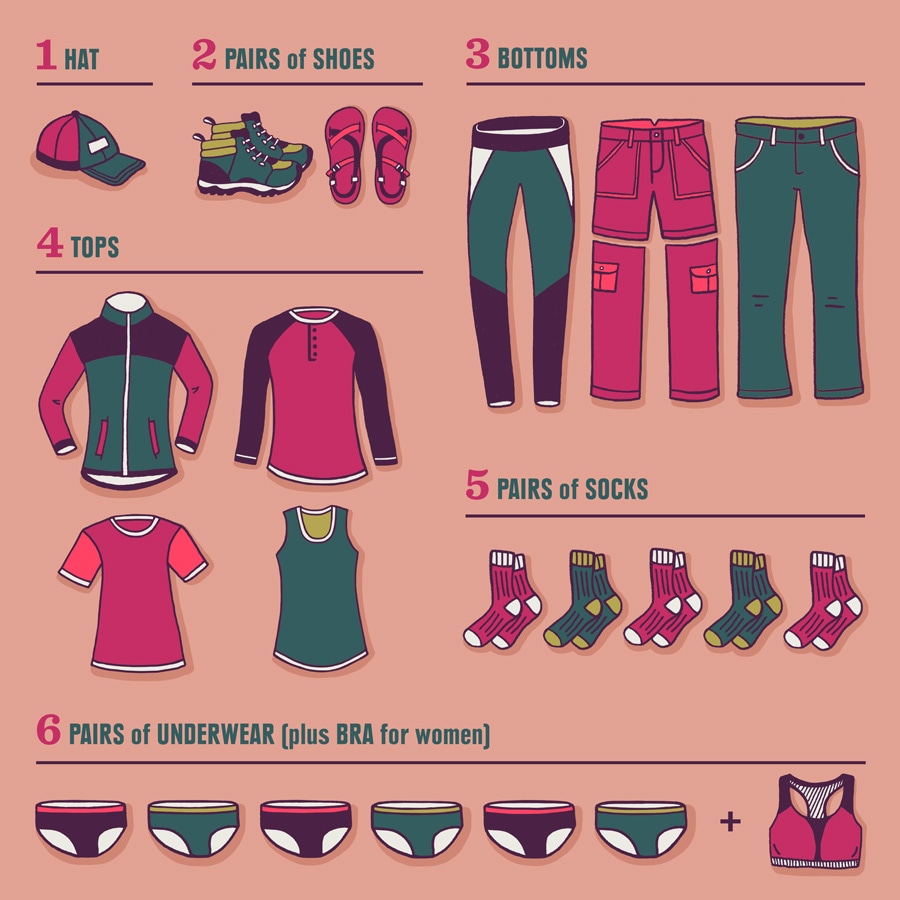
One general guideline is to pack one hat, two pairs of shoes, three bottoms, four tops (short or long-sleeve or outer layer), five pairs of socks, six pairs of underwear. This should be enough to last you for two weeks. Beyond that, customize your pack list to include swimwear, rainwear or other specific items related to your trip. You may not need all of it (pack even less if you can), but this would get you through six days before you have to do laundry. No matter how long your trip is, try to limit yourself to no more than seven days’ worth of clothing. Get used to wearing clothing more than once (no one really notices or cares). Also, plan on doing laundry on the road.
Make a Packing List
It seems obvious, but make a packing checklist of things you need and things you want. Then cut that list of wants in half. If you’re not absolutely sure you’ll need something, don’t take it. (You can typically buy, rent or find most things at your destination). Lay out all of your planned clothes and gear before you go and think carefully about each item.
Make Sure Every Item Does Double Duty
Pick your clothes carefully. Given two choices, pack the item that serves more than one purpose and weighs less or takes up less space. Here are a few examples:
- A poncho can replace a rain jacket, umbrella or backpack rain cover.
- A sarong can be used as a towel, picnic blanket or skirt.
- Convertible pants aren’t glamorous and people either love them or hate them. But they’re functional, rugged and quick-drying: Zip off the lower half for that hot hike and convert back to longer pants to go to dinner or visit a temple. If zip-offs aren’t your jam, try roll-up pants with button tabs above the ankle or near the knee.
- Instead of a long- and short-sleeve shirt, consider one with roll-up sleeves.
- Use a bandana or Buff neckwear to keep your neck warm, protect your head or neck from the sun or use as a sleep or smog mask.
- Pack shorts that you can hike in, swim in and walk around town in.
- Running shorts and a sports bra can also be used as swimwear.
Layer Your Clothes
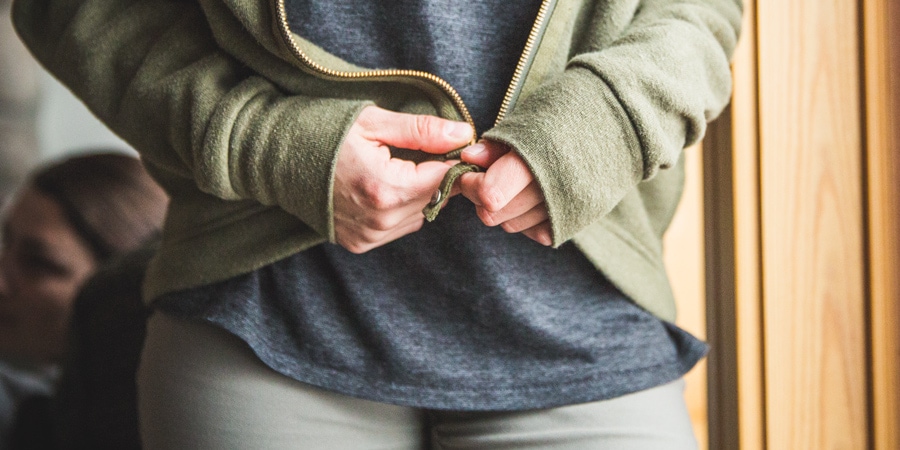
Pack versatile layers that you can put on or take off as weather and temperature conditions change. Think like a hiker or backpacker when layering clothes for your next adventure travel. Rather than pack one bulky sweater, layer a short-sleeve shirt with a long-sleeve top. In colder climates, add a lightweight packable jacket. This gives you many more outfit options without adding too much weight or volume. Before your trip, make sure your outer layer fits easily over your inner layer(s) without bunching up. Read our article on layering basics.
Choose Light, Quick-drying Fabrics
Pick performance fabrics that breathe well, keep moisture away from your body, wrinkle less and dry faster. You probably have some items in your closet already. If you splurge, let it be on clothing made of merino wool—which doesn’t retain odor after multiple uses, breathes well and is lightweight. If you’re on a budget, invest in choice items like quick-drying socks or underwear and add to your travel wardrobe over time. Synthetic fabrics also pack well and dry quickly. For a warm outer layer, consider a lightweight synthetic or down insulated jacket that packs up small and provides impressive warmth for its weight. Read more tips on how to choose travel clothing.
Pick Neutral Colors
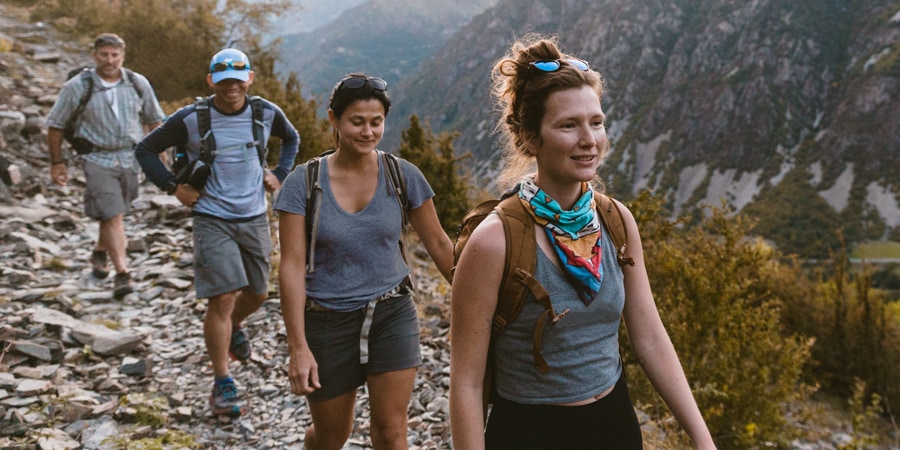
Stick with a simple color palette to easily mix and match tops and bottoms for several outfit combinations. Black and darker colors look cleaner longer than light colors and tend to be more sophisticated when you go out to dinner. Add a splash of color with a bandana or Buff neckwear.
Plan on Doing Laundry
Unless you have the luxury of hotel laundry or dropping your clothes at the cleaners, doing laundry is part of traveling light. The good news is that it doesn’t require much effort.
- Practice washing your clothes in a sink to see how long it takes to dry.
- Pack a small bar of biodegradable soap – this can also be used for any of your cleaning needs (hair, body, laundry and dishes).
- Wash items while you’re showering.
- Wringing out wet clothing can stretch and disfigure them. Before hanging your clothes to dry, lay your clothes out flat on top of a towel and roll the towel up. Wring out excess water to speed up drying.
Bring Multipurpose Footwear
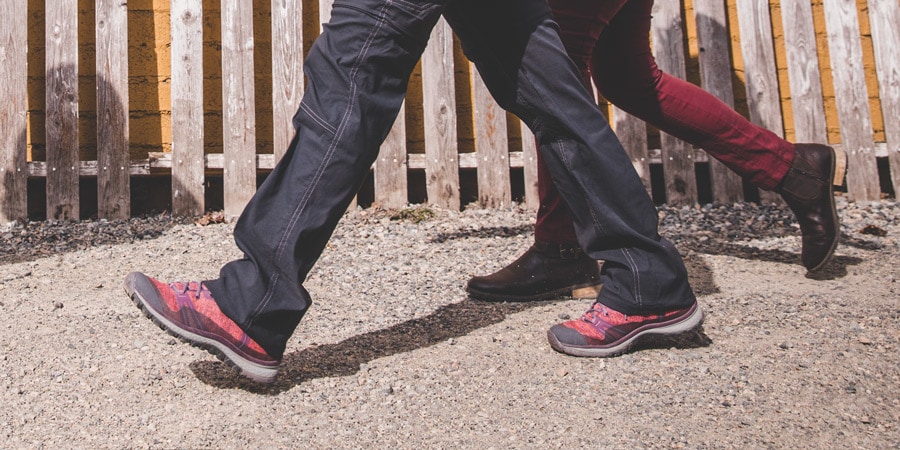
Most travelers can get by with two pairs of shoes, depending on what kind of trip they’re taking. Wear the heaviest pair on the plane or on travel days.
- Think multiuse (e.g., running shoes can work for running, walking and hiking).
- Consider light trail-running shoes instead of bulky hiking boots because they offer maximum versatility and they’re good for hiking, running or walking.
- Make sure your shoes are comfortable and broken in beforehand to help reduce blisters.
- Measure your feet to get the best fit when buying footwear. Consider getting a boot or shoe that is one or one-half size larger because your feet tend to swell, especially in hotter climates.
Leave Most Toiletries at Home
If you can get toiletries at your destination, leave them at home. When you book your hotel, guesthouse or apartment, ask if they supply items such as shampoo, lotion or razors. If it’s not something you need every single day (toothpaste, toothbrush or contact solution), consider leaving it out.
- Bring sample-size toiletries, including toothpaste—the TSA does not permit containers larger than 3.4 oz. in carry-on bags.
- Consider alternatives to liquids.
- Buy toiletries upon arrival and try what the locals use.
- Just because you’re allowed to take 3.4 ounces of liquids doesn’t mean you need that much sunscreen or lotion. Consider transferring toiletries into even smaller travel tubes, pill boxes or storage bottles.
- Take products that have more than one use.
Ditch Your Laptop
If you don’t need your laptop, don’t bring it. Most smartphones now do all the things that a computer does and take up a lot less space. A tablet or e-reader loaded with music, books and maps can save weight and volume. Here are a few more tips for your electronics:
- Bring a small media-storage device for transferring, storing and backing up your photos. Or upload your photos to a cloud-based server when you’re connected to the internet.
- Pack a small portable battery pack so you can charge on the go.
- Bring an electrical adapter with multiple USB ports. This will come in handy when you’re trying to plug in and charge at a public place like a café, hostel or locations where outlets are limited. Read more in our article on How to Choose Travel Power Adapters.
Choose the Right Luggage
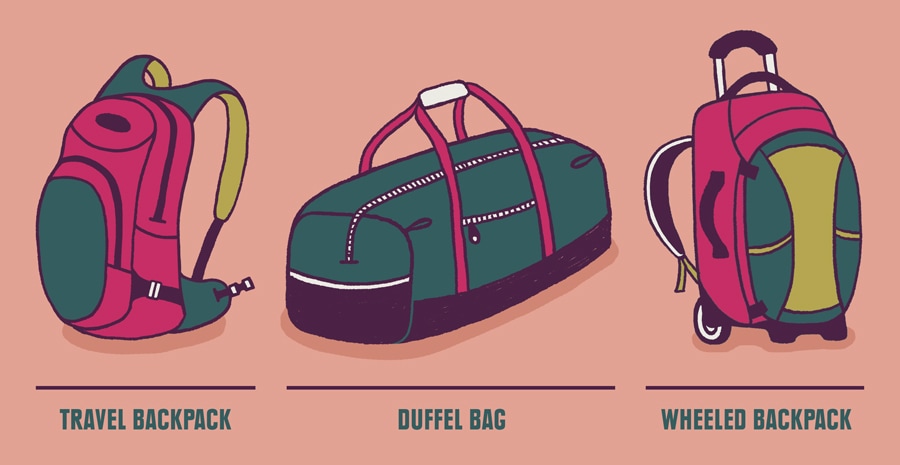
Think small and light. Aim for one carry-on bag if possible. That may not always be practical but challenge yourself to start small and make it fit. Resist the urge to use a bag larger than needed or you’ll be tempted to fill it. The right luggage will depend on the type of travel you’re doing and what you’ll be doing there.
- If you’re exploring multiple destinations or spending a lot of time on trains, buses and between hostels or hotels, a travel pack with shoulder straps is your best bet for mobility and versatility. Many travel-specific backpacks have nice compartments and features, but a traditional backpack works just as well.
- If you’re going on a safari or bike tour where a guiding company will schlepp your gear, then duffel bags make good choices because they’re durable and affordable.
- Families with young kids or travelers who won’t be moving around a lot may want to consider wheeled backpacks for versatility and convenience.
Need help choosing luggage? Read our article on How to Choose Luggage, Packs and Bags.
Use Packing Organizers
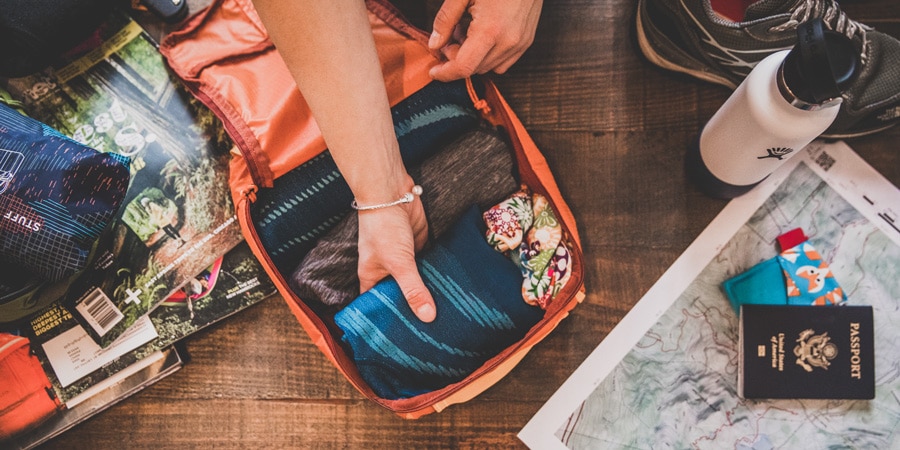
Roll your clothes and use packing cubes, stuff sacks, compression bags or cheap zip-top bags to maximize space and keep your things organized. Packing organizers make it easier to find what you need quickly without having to rummage through everything in your bag. Compression bags squeeze things down by removing excess air but be sure you don’t end up adding extra weight by packing more. If you’re carrying a travel backpack, you may find that stuff sacks fit better than rectangular packing cubes.
Weigh Your Bag
Before you leave, pack your bag and practice carrying it around and lifting it up and down. Too heavy? It’s easier to ditch things at home. Some airlines have limits on size and weight; check specific airlines for rules and restrictions. For adventure travel where you’re hiking for days, aim for about 10 percent of your body weight. (If you weigh 150 pounds, that means a 15-pound pack or less). Also, double-check TSA regulations for a full list of what you can and can’t bring.
Prepare for Lost Bags
Luggage can get delayed or lost. Be sure to keep these essentials with you in your carry-on bag: passport, money, eyewear and medication. Whether you check bags or have a carry-on bag, make sure to wear what you’ll need for a day or two in case the airline loses your luggage. Wear or carry the heaviest and bulkiest items or that are hardest to replace such as hiking boots.
Decide Whether to Rent or Ship Your Gear
The types of gear you pack will greatly depend on your adventure, what you’ll be doing and the climate at your destination. Decide what gear is most important to you and how pivotal that equipment is to your adventure travel. If you’re biking lots of miles over several days, it may make sense to ship your bike because you’re accustomed to its fit and feel. (Read more tips in our article on How to Ship a Bike). If you only need gear for one or two days of your trip, consider renting equipment. Weigh the costs of renting and bringing gear along; sometimes it’s cheaper to bring your gear. If you’re booking a trip through REI Adventures, you’ll find specific gear checklists that tell you what you’ll need to bring and what will be provided.
Customize our adventure travel checklist for your trip.
Go Carry-on if You Can
Having a carry-on bag ensures your luggage stays with you at all times and won’t get lost. Airline passengers are generally allowed to bring aboard one personal item and one carry-on bag for no charge. There is no federal standard for carry-on bag size, so always check your airline’s latest carry-on rules. It must be able to fit in an overhead compartment or under the seat.
The limitation of carry-on bags is that the Transportation Security Administration (TSA) restricts what you can bring. Some personal items, sporting goods and tools can only be taken if checked. Visit TSA’s list of permitted and prohibited items for a complete list.
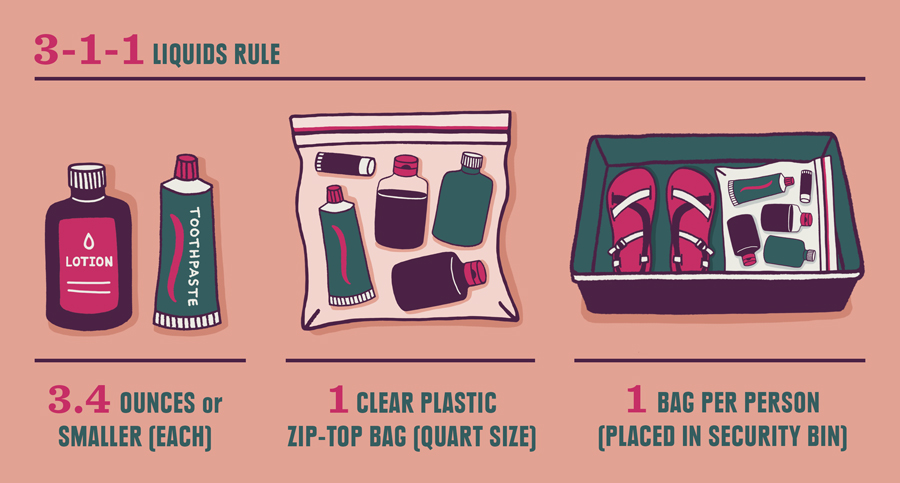
The TSA says the “3-1-1” liquids rule for a traveler’s carry-on bag is:
- 3.4-ounces or smaller containers of liquids and gels
- 1-quart size, clear plastic zip-top bag (all liquids must fit in bag)
- 1 zip-top bag per passenger
Note: There are some exceptions for essential liquids, such as baby formula and medicines.
Check Your Bag if You Have To
You’ll have fewer security hassles if you check your bag. Some items cannot be carried on and must be checked. If you’re taking an ice axe, ski poles or Swiss Army knife—items that could also be considered weapons—your bag will have to be checked.
Traveling light is to your benefit even when checking your bag. Why? A light bag doesn’t run the risk of incurring an overweight baggage fee. Plus, once at your destination, you still need to haul it around. A light bag means greater comfort and freedom.
Follow These General Travel Tips, Too
- Leave jewelry and valuables at home and never pack anything fragile in your checked baggage.
- Carry your credit card, cash, medicine, keys and passports close to you in a security belt or pouch.
- Write your name and contact info on the inside of your bags in addition to the outside, as tags can get torn off.
- Consider sending souvenirs home so you won’t have to lug them around; check carriers and costs before leaving home.
- Pack a lightweight, zippered collapsible bag. It can work for a beach tote, shopping bag or an extra bag to bring souvenirs home.
- Leave a copy of your trip info at home and/or with a traveling companion.
